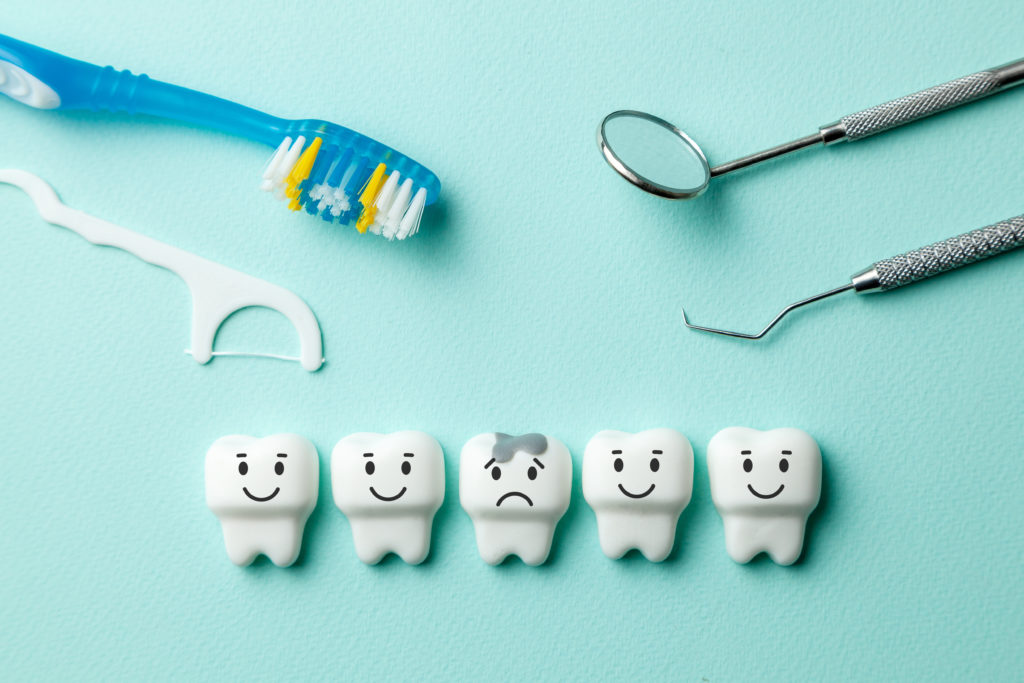Tooth decay is an infectious disease that affects children and adults alike. According to theWorld Health OrganizationHalf of the world's population (3.58 billion) suffers from oral diseases, the most common being permanent tooth decay". What is tooth decay? What are its symptoms? How can it be treated? Can tooth decay be prevented? Find out all the answers to these questions in our article.
What is tooth decay?
Caries is a cavity that forms as a result of the destruction of enamel, then dentine. The culprits? Bacteria that attack teeth, the consumption of sugars and certain behaviours that are harmful to oral health.
Tooth decay always starts on the tooth surface. If not treated in time, they progress to the tooth pulp. Complications of untreated decay include toothache, abscess and infection. In extreme cases, tooth decay can lead to permanent tooth loss.
If left untreated, the caries process will progress irreparably. Only the intervention of a dentist can stop the spread of the disease into the tissues surrounding the tooth.
What are the risk factors?
All people, regardless of age, are at risk of developing cavities at some point in their lives. However, there are many factors that contribute to the development of this infectious disease in the oral cavity. Here are the main ones:
- Poor oral hygiene
- Ineffective or partial tooth brushing
- Wearing dental appliances
- Poor positioning of teeth
- Fluoride deficiency
- Unremoved plaque that turns into tartar
- Dry mouth (lack of saliva)
- Gastroesophageal reflux disease (GERD) and heartburn
- High consumption of sweet products
- Nibbling
- Eating disorders such as bulimia and anorexia
How can you tell if you have tooth decay?
In the early stages of tooth decay, patients are generally unaware of any signs. The decay is still superficial. That's why it's essential to visit your dentist at least once a year. He or she will be able to detect this infectious disease and treat it in time to avoid more serious consequences.
If left untreated, patients with cavities may notice the following symptoms:
- tooth sensitivity
- formation of small holes on teeth visible to the naked eye
- white, brown or black spots on the surface of the teeth
- localized pain or pain affecting part of the face, with no apparent cause
- tooth pain when biting into food or consuming sweet, acidic, hot or cold foods or beverages
- toothache, one of the most common reasons fordental emergency in Lausanne
- dental abscess (bacterial proliferation in the gums, ligaments and/or bone)
These signs should raise your alarm and prompt you to make an appointment at a dental practice without delay.
What preventive measures should you take?
Prevention is essential to limit the risk of cavities forming in your mouth. A good oral hygiene offers you the assurance of healthy teeth and, more generally, a healthy mouth.
First of all, we recommend brushing your teeth at least twice a day using a fluoride toothpaste. The toothbrush can be complemented by dental floss, a rinse or other accessories to thoroughly clean your mouth.
Visit your dentist regularly. We recommend at least one visit a year for healthy adults and two visits for children. This gives you the opportunity to have your teeth and gums scaled and checked.
As far as your diet is concerned, reduce your consumption of sweet products (sodas, sweets, cakes, but also industrial products). At the same time, try to avoid snacking between meals. Every time you consume a food or drink (other than water), you increase the risk of bacterial attacks.
Don't hesitate to consult a dental hygienist in Lausanne, for example. This professional is specially trained to educate patients on how to improve their oral hygiene.
How to treat a decayed tooth
Contact your dentist in Lausanne or elsewhere in Switzerland to treat your cavities. Treatment varies according to the stage of the disease. It's important to remember that the part of a tooth destroyed by decay cannot repair itself naturally. The earlier the disease is treated, the less invasive the treatment and the less expensive it is.
First stage: decay only affects tooth enamel.
Your dentist will seal the grooves or remineralize the enamel with fluoride varnish.
Second stage: the decay reaches the dentin surface.
The dentist begins by removing all infected tooth tissue. He fills the cavities in the tooth caused by decay using dental amalgam (an alloy of mercury and silver), commonly known as a filling, or an adhesive composite cement. The latter option is more aesthetically pleasing, since its color is identical to that of the tooth.
Third stage: the cavity penetrates deep into the dentine.
The patient has usually suffered significant loss of tooth substance. In this case, the dentist takes an impression of the affected tooth and sends it to a specialized laboratory. The lost tooth substance is replaced by a composite resin or ceramic substitute (inlay-onlay).
Fourth stage: decay affects the tooth pulp.
Devitalization of the tooth becomes necessary. Pulp tissue is removed. The dentist disinfects the root canals before filling them. Finally, the shape of the tooth is reconstructed with a prosthetic crown.
HELVIDENT has dental clinics in Lausanne, Fribourg and Aigle in the French-speaking part of Switzerland. Our team of dentists provides comprehensive oral health care. Get in touch with us to make an appointment as soon as possible.

